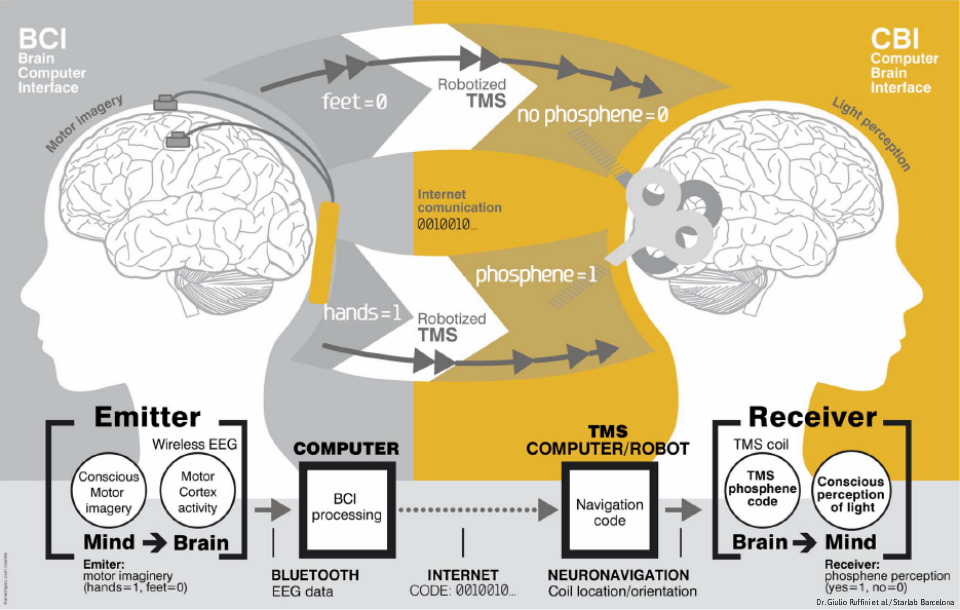Filtered By: Scitech
SciTech
The Science of Pacific Rim: Brain-to-brain communication makes 'drifting' possible
By MATTHEW ARCILLA

Establishing for the first time that direct brain-to-brain communication is possible, a study demonstrates that it is possible to transmit thought from one person's mind to another miles away without the aid of speech or writing, nor the use of invasive technologies.
Essentially, a reading of the transmitting person's brain pattern for a specific word was converted into an electrical signal and transmitted over the internet. On the receiving end, the signal was converted into light flashes that the recipient could see and decipher.
In a paper entitled "Conscious Brain-to-Brain Communication in Humans Using Non-Invasive Technologies," the authors stress that this is a form of "mind-to-mind" transmission as opposed to "brain-to-brain," because "the origin and the destination of the communication involved the conscious activity of the subjects."
A team of scientists led by Dr. Giulio Ruffini of Starlab Barcelona in Spain successfully transmitted the words 'hola' and 'ciao' between two human subjects using electroencephalogram and robot-assisted and image-guided transcranial magnetic stimulation technologies linked together by the Internet.
The interface is reminiscent of the brain-to-brain "drifting" technology that is a cornerstone of the hit movie, Pacific Rim:
The interface is reminiscent of the brain-to-brain "drifting" technology that is a cornerstone of the hit movie, Pacific Rim:
Similar studies in the past have explored communication between a human brain and a computer.
Such studies make use of electrodes attached to a person's scalp to transmit action-thought to a computer which translates the signals into instructional outputs for a wheelchair or a robot. But in this study, the team added a second human brain on the other end of the system.
Such studies make use of electrodes attached to a person's scalp to transmit action-thought to a computer which translates the signals into instructional outputs for a wheelchair or a robot. But in this study, the team added a second human brain on the other end of the system.
Leveraging existing brain pathways
"We wanted to find out if one could communicate directly between two people by reading out the brain activity from one person and injecting brain activity into the second person, and do so across great physical distances by leveraging existing communication pathways," said researcher Dr. Alvaro Pascual-Leone.
"One such pathway is, of course, the internet, so our question became, 'Could we develop an experiment that would bypass the talking or typing part of internet and establish direct brain-to-brain communication?'"
"One such pathway is, of course, the internet, so our question became, 'Could we develop an experiment that would bypass the talking or typing part of internet and establish direct brain-to-brain communication?'"
Four participants, aged 28 to 50, participated in the study. One was assigned to the brain-computer interface (BCI) that sent the words, the rest were assigned to the computer-brain interface (CBI) to receive the messages and understand them. The two interfaces were separated by a geographical distance of over 5,000 miles between India and France.
A similar experiment was conducted between individuals in Spain and France, with the end result a total error rate of 15 %, 11 % on the decoding end and 5 % on the initial coding side.

Transmitting emotions: 'sense synthesis'
A similar experiment was conducted between individuals in Spain and France, with the end result a total error rate of 15 %, 11 % on the decoding end and 5 % on the initial coding side.

Transmitting emotions: 'sense synthesis'
According to the research team, the success of this experiment proves that communication beyond conventional means is feasible, and in the future could likely provide new avenues of communication for the disabled.
"Although certainly limited in nature these initial results suggest new research directions, including the non-invasive direct transmission of emotions and feelings or the possibility of sense synthesis in humans," they said.

"Although certainly limited in nature these initial results suggest new research directions, including the non-invasive direct transmission of emotions and feelings or the possibility of sense synthesis in humans," they said.

The researchers also suggest that the ability to send messages between people's brains can lead us to a future where interaction with computers is entirely different. The possibilities carry social implications that must be considered.
"In the not-so-distant future [computers will] interact directly with the human brain in a fluent manner," they wrote.
"The widespread use of human brain-to-brain technologically mediated communication will create novel possibilities for human interrelation with broad social implications that will require new ethical and legislative responses." — TJD, GMA News
"In the not-so-distant future [computers will] interact directly with the human brain in a fluent manner," they wrote.
"The widespread use of human brain-to-brain technologically mediated communication will create novel possibilities for human interrelation with broad social implications that will require new ethical and legislative responses." — TJD, GMA News
Tags: pacificrim, cybernetics
More Videos
Most Popular



